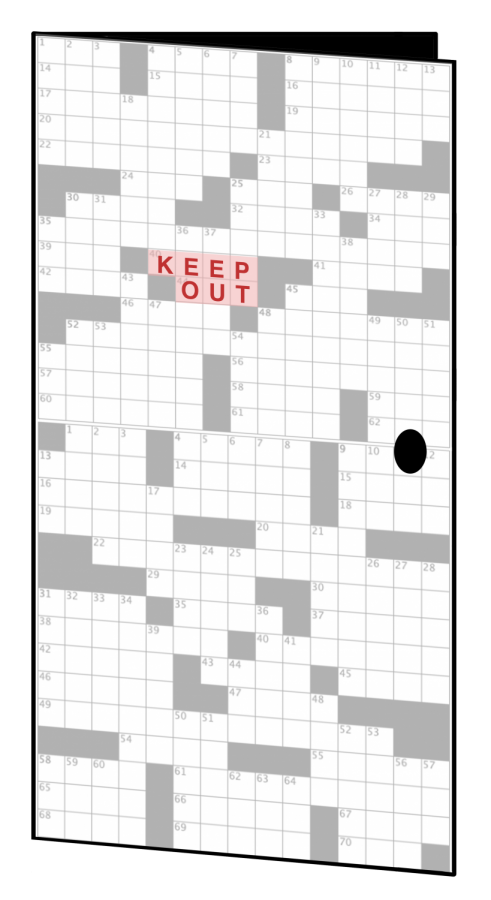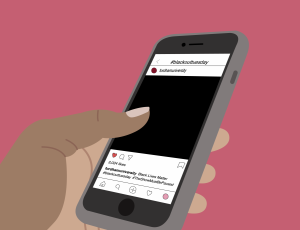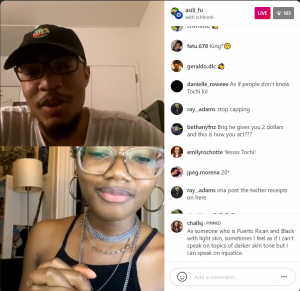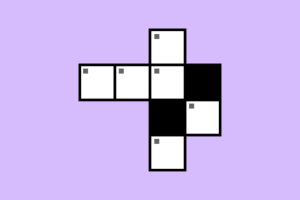Boxed Out
Exclusion and bigotry in the world of crossword puzzle construction, and what is being done to diversify
June 16, 2020
For many people, solving crossword puzzles is a fun and lighthearted activity, perhaps accompanied by breakfast or Sunday brunch. For such a seemingly harmless and amusing pursuit, the modern mainstream crossword puzzle has an extensive record of excluding the voices of people of color, women and the LGBTQ community, as well as employing dated or offensive terminology.
The pattern of exclusion has, however, prompted pushback which provides hope for the growth of a new generation of diverse and mindful crossword enthusiasts.
Exclusion of Diverse Constructors and Clues
According to an April 2020 Vice article by Samantha Cole, “New York Times Crossword Constructors Are Fighting Against its Systemic Bias,” the New York Times crosswords, considered by many to be the gold standard of cruciverbalism (the construction of crossword puzzles), “often seem targeted at imagined solvers who are older white males.”
“That crossword mainstays such as The New York Times, the Los Angeles Times, and The Wall Street Journal are largely written, edited, fact-checked, and test-solved by older white men dictates what makes it into the 15×15 grid and what’s kept out,” Natan Last wrote in a March 2020 article for the Atlantic entitled “The Hidden Bigotry of Crosswords.” Last is a crossword constructor for the New York Times and The New Yorker. His article brings to light the fact that the lack of diversity among mainstream crossword creators, editors and test solvers leads to a lack of diversity in the grids and clues of the puzzles themselves with regards to race and ethnicity, age, and gender and sexuality.
For example, since the current New York Times crossword editor, Will Shortz, assumed the position in 1993, the percentage of crossword bylines by women has fluctuated between 13% and 27%, according to xwordinfo.com. While there has been no particular trend of growth, it has reached a high of 28% so far in 2020.
Even when puzzles are constructed by diverse voices, they may be censored during the editorial process: “Constructors constantly argue with editors that their culture is puzzle-worthy, only to hear feedback greased by bias, and occasionally outright sexism or racism,” Last wrote. Flavor Flav, Marie Kondo and Gay Erotica are among crossword entries that have been rejected by editors for being “not familiar enough,” “risky” or “ephemeral.”
There are “way too many famous O’HARAs and TARAs for there to be all these gone with the winds references in crossword puzzles,” Erik Agard, the crossword editor at USA Today, wrote in a tweet. The pattern of omission can be a deterrent to a younger and more diverse audience of solvers, who are often familiar with the figures and aspects of culture that tend to be excluded from these puzzles in favor of archaic references.
Crossword constructor Finn Vigeland said in a New York Times interview that he was surprised to be told that the author and activist bell hooks (whose name is stylized in lowercase) was not “familiar enough for The Times’s crossword audience.”
“I’d love to see the New York Times Crossword get a little blacker, gayer, more female. Obviously, that goes for the demographics of constructors, too, but also the makeup of the grids,” Vigeland continued.
Offensive Language and Missteps
Signs of racism, sexism and bigotry are not only to be found in who and what are excluded from the crossword world, but also more explicitly in a history of controversial, offensive, tone-deaf and/or uncomfortable words and clues that have been included in popular crosswords throughout the years. Adrianne Jeffries listed several examples of the New York Times’ crosswords’ “stodginess” in a 2017 article for The Outline entitled “The NYT Crossword is Old and Kind of Racist.”
These include the use of words that have been discouraged or outright banned from the rest of the newspaper in its style guide, such as “Oriental” as a racial description (after being banned in the Times’ 1999 style guide), “transvestite” (labeled offensive in the style guide) and “Eskimo,” a nonspecific term invented by colonizers (“The crossword, by its nature, makes the word more offensive by oversimplifying its meaning and depriving it of context,” Jeffries wrote).
In 2012, the word “illegal” was clued as a noun: “One caught by the border patrol.” When asked about this clue, Will Shortz responded that “At the time I wrote this clue (and yes, it was my clue), I had no idea that use of the word ‘illegal’ in this sense (as a noun) was controversial,” but that he did not intend to offend and that the word would not be clued that way again. A few months before this, however, the use of the word in an opinion article had received backlash already.
“Place with homies” was used as a clue for the word “hood” in a 2015 puzzle. Michael Sharp, a crossword constructor and critic who runs a blog called “Rex Parker Does the NY Times Crossword Puzzle,” wrote that “Since the NYT crossword has generally demonstrated little to no awareness of black lives, it’s weird to have ‘homies’ keep coming up—it means that black people are visible in the puzzle, for the most part, only via some street slang that white people picked up 20+ years ago.”
Just 17 days later, another puzzle published “Gangsta rap characters” as the clue for the word “thugs.” Sharp wrote that the choice, “however defensible from a strictly literal standpoint,” is “terrible in the age of #BlackLivesMatter,” given that many “racist white people are wielding ‘thug’ like a racial epithet.” The Times crossword puzzle “not only barely acknowledges black people exist,” he wrote, “but when it does, only does so via clues gleaned from a cursory (and often dated) understanding of rap and hip-hop.”
In 2016, “harem” was the answer to “Decidedly non-feminist women’s group,” which a responder on Twitter called “unnecessary and awful while also managing to be demeaning to both sex workers and women in sex slavery.” It was tone-deaf at best, according to a Slate article by Ruth Graham titled “Why is the New York Times Crossword So Clueless About Race and Gender?”
The problem is compounded by “the fact that crossword puzzles deal in authoritative definitions,” Graham wrote. They create an equivalency between clue and answer that allows for the oversimplification of words that may have complex histories. What’s more, the crossword’s identity as a fun puzzle has likely shielded it in part from the level of scrutiny applied to other sections of newspapers and magazines.
It seems clear that the instances of offensive language have been inadvertent and not intended to cause harm, and apologies have sometimes been issued. However, the fact that these errors have been allowed to happen at all reveals the need for younger and more diverse voices at major publications throughout the editorial process — a process which remains ignorantly and embarrassingly stuck in the past.
Pushback From Crossword Constructors
There is an engaged online community of solvers, constructors and crossword bloggers who provide much-needed critiques and call out publications for the racism and sexism sometimes displayed in their puzzles. New avenues for growth in the industry have also been bubbling up beneath these mainstream crossword-producing publications.
The examples listed and the culture that produces them serve to alienate many solvers and have also discouraged and disheartened constructors who submit puzzles to the crossword sections of major publications.
Earlier this year, a group of nearly 600 supporters, mainly crossword constructors and solvers, signed a letter to The New York Times’ executive director of puzzles, Eric von Coelln.
“Our intention is not just to register concern or to chastise an institution that we love, which has thrived under the visionary leadership of Will Shortz. Instead, we are asking for three concrete measures that we think can correct for the blindspots of his system,” they wrote. The letter proposed that constructors be given proofs of their puzzles before publication to look over changes made by the editors; that at least half of the Times’ test solving team be women and/or non-binary solvers; and that the paper publicly commit to diversifying the editorial staff: “we still believe strongly that diversifying the puzzle means diversifying those who most closely shape it.”
In a response to the letter, von Coelln promised to make the process more digital and more transparent and increase communication with constructors, including sharing edited proofs. Muscat did not feel that the response was sufficient yet, but was grateful to The Times for having the conversation.
Earlier this year, constructor Rebecca Falcon coordinated a “Women’s March” for the crossword world, signing on publications to publish crosswords made by women during the month of March, Women’s History Month. Universal Crossword’s march even extended into April. The New York Times participated for a week.
As well as advocating for a more inclusive process at large publications, constructors have also created forums designed to host a new brand of modern puzzles. Women of Letters has published puzzles made by women, and The Inkubator encourages puzzles to explore feminist, queer, activist and edgy themes. Another organization, Queer Crosswords, features puzzles created by LGBTQ constructors, which are accessible in exchange for donations to organizations that support the LGBTQ community.
Moving Forward
These developments are encouraging, but there is still a lot of work to be done to make these inclusivity efforts comprehensive. There has not been a lot of conversation or data about the absence of voices of people of color in the world of crosswords, or explicit initiatives to increase racial diversity among constructors, test solvers and editors. When asked by if the crossword community is becoming more inclusive, Agard told The Observer, “i think it’s moving in that direction, but way too slow.”
At USA Today, Agard is actively working to make the crossword more inclusive. In his article, Last reported that “Almost every USA Today byline has been a woman or a person of color, thanks to Agard’s active recruitment.”
While “a lot of the conversation and outreach on inclusivity has focused on women, which has led to some good strides, both in terms of representation in existing puzzle venues and the creation of new women-led spaces like the inkubator and women of letters,” Agard said, “i need all of that same energy for other underrepresented groups. i’m trying to live to the day when i get to regularly solve a crossword that’s by and for black folks. that feels far off right now.”
He added that it is the responsibility of white, male, cis-gendered and straight constructors as much as anyone else’s to work towards inclusivity within their clues and answers.
“there are constructors who will sink hours into making sure they get a Q, an X, a J, and a Z in their puzzle, but can’t seem to be bothered to work one black name in. it’s embarrassing. if we can’t collectively get those priorities straight, i don’t wanna think about where we’ll be at in a few decades.”
Agard co-founded a Facebook group called the Crossword Puzzle Collaboration Directory, along with fellow puzzle constructor Will Nediger to provide a network and resources for more diverse puzzle making. It is “often said that talent is equally distributed, but opportunities are not. this group’s foundational intent is to rectify that inequity for women, people of color, and folks from other groups underrepresented in the puzzle world,” Agard wrote in a post to the group on Jan. 9, 2018.
His advice to new constructors and people looking to get involved is that “there’s a lot of good resources (both people and things) out there – take advantage. get construction software and a wordlist. check out the crossword puzzle collaboration directory on (unfortunately) facebook for tutorials and mentors. be patient. be undauntable and undiscourageable.”
Agard wrote, “to paraphrase toni morrison, make the puzzles you wish you could solve.”















Steven Goldman • Aug 13, 2020 at 1:33 pm
any way. Came back to see if my original comment cleared, and it appears the iPhone auto correct has betrayed again.
Steven Goldman • Aug 11, 2020 at 10:47 pm
I recently started picking up the USA Today again after a 2 year hiatus, and noticed this subtle change in clues. My curiosity led to reading this article. This shift does not bother me in anyway, and I think it’s great if younger people are drawn in as a result. Without the backing of any scientific study, I believe solving crosswords are an excellent exercise for young minds. I started during my freshman year of college in between spaced class times, which seemed to help with memory and retention. My question has to do with the number of people that have an interest and/or ability to construct puzzles. It would seem like the numbers meeting both criteria would mirror needle in a haystack probabilities. When building more complex challenges, like my fellow IU alum Will Shortz and Mr. Agard generate, candidate pool would shrink considerably. Have you considered that minimal interest from potential candidates has limited diversity more than perceived systematic bias?